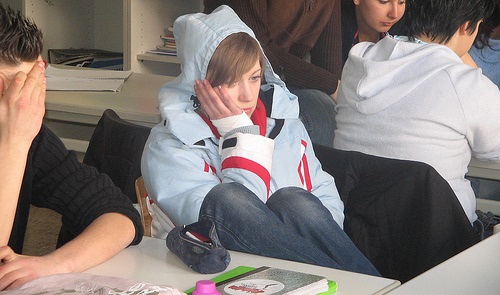When I was a high school theology teacher, there were two incredibly intelligent students that, I have to admit, were a challenge to teach.
Ben and Jerry (not their real names) were smarter than me and they liked to show it.
Any chance they got, they would question what I was teaching with counter-arguments and objections.
The upside was that I found myself trying to prepare for the objections, creating a defense for them before they started.
The downside was, though, that whether I “won” or “lost” an argument, I never felt like anyone was any better off as a result.
I’m glad I was teaching them about social justice.
It was my first year teaching a course on Catholic Social Teaching and I was flying by the seat of my pants. I was constantly researching and barely reading one textbook section ahead of the one I was teaching on any given day.
Toward the end of the first semester, I started getting compliments from other teachers and parents who had heard great things about the course from their kids. The kids actually liked the class. I barely knew what I was talking about, but the kids were connecting with what I taught.
Believe it or not, even Ben and Jerry connected with the lessons in social justice too. They got fired up in objections, not against what I said, but in against the corrupt social structures.
When I think back on the experience, I can only believe that it wasn’t my great teaching skills that made the impact, instead it was the way that the content made them feel.
Most of us spend our time crafting sound, rational arguments and defenses for our Catholic doctrine. We want to be excellent apologists.
The problem, though, is that we can’t incite conversion in the hearts of those we teach by changing only their minds.
When we can’t change what students think, let’s change what they feel.
In the end, this is a much more effective way to introduce young people to the love of God. By recognizing that love–maybe even feeling it in their hearts–they will be much more willing and likely to be motivated to search for the answers on their own without our help.
Two Types of Lesson Objectives
As religious educators, we must set two kinds of goals for our students during each lesson. We want them to be able to show us they have learned what we taught but we also want them to feel motivated to apply what they have learned to their everyday lives.
In this video I explain the two types of lesson objectives you should include in your lesson plans: SWBAT (Students Will Be Able To . . .) and SWF (Students Will Feel . . .).
Six Ways to Change How Your Students Feel
Focus on how you can change the way your students feel. Then, you might be able to change the way they think.
Here are some ways to create a change in feeling and set them up for a change in thinking:
1. Ask yourself: How do I want them to feel at the end of this lesson or activity?
This may seem like a no-brainer, but I’m guessing you haven’t done it. I never did. By default, I like to think about what I want students to be able to do and completely ignore the feelings they will have as a result of a lesson.
When you start to think about how your lesson can incite a change in feeling, you begin to see your role in a different way.
You’re not just a teacher, you are an evangelizer.
2. Talk to students before or after class.
Get to know your students. The best way to do this is while they gather for class or when they leave. I wrote about this in more detail for Day 10 of 31 Days to Becoming a Better Religious Educator.
3. Go to their basketball games, mock trials, or dance recitals.
Find out what they are interested in and then find out how you can get involved. Kids loved it when I came to their games and shows.
You might even take it a step further: become a coach. I’ve always felt that I was able to be a better minister on the football field and the track than I was in the classroom (so does Play Like a Champion Today).
4. Write a note of praise for your students.
Make it simple and specific. If they did well, let them know it. You’ll earn their trust and they will be better listeners.
Plus, they deserve it.
. . . and they don’t hear it enough anyway.
Read more: Day 11 of 31 Days to Becoming a Better Religious Educator.
5. Call home, but give a compliment.
Parents rarely hear from their teachers and catechists these days. And when they do, it usually isn’t a good sign.
Call home with a compliment. You might be surprised by their gratefulness and the stories they will tell.
If you can’t call, then send an email. It’s not as powerful, but it still works.
Read more: Day 12 of 31 Days to Becoming a Better Religious Educator.
6. Teach stuff that matters.
In my experience teaching Ben and Jerry, it was the content that appealed to them the most. The kids you teach who call themselves atheist or agnostic aren’t heartless. They are in search for Truth with a capital “T” and they are not satisfied by the answers to their questions.
Give them the Truth, but make sure it appeals to the heart.
I was blessed to be able to teach social justice, but you can present a lesson on any subject and still make it appeal to the heart.
The easiest way to do this is to use real stories. Your witness stories will always work best, but gather other stories as well. Find why saints love the concepts you are teaching. Share stories from the Bible, but don’t just present the facts, spend some time considering how the people in the stories felt and relate with them.
When you connect real stories with the presentation of the Truth, then you will be able to present your lessons in such a way that the young people will respect you for teaching them something that actually matters (even if they don’t agree with what you say).
These thoughts were inspired by Bernadette Jiwa’s TEDx talk and this–now viral–“letter to the young teacher down the hall.”
(photo credit: kaswenden)




Great post, Jared! I especially identify with the “try to prepare oneself in advance for whatever possible arguments these students might think of.”
Critical thinking is missing from Catholic teaching. Feelings are fleeting. Teach them to think. Thank you for your great website.